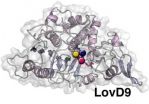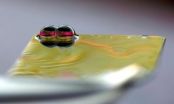(Press-News.org) Lincoln, Neb., May 14, 2014 – A chimpanzee will wait more than two minutes to eat six grapes, but a black lemur would rather eat two grapes now than wait any longer than 15 seconds for a bigger serving.
It's an echo of the dilemma human beings face with a long line at a posh restaurant. How long are they willing to wait for the five-star meal? Or do they head to a greasy spoon to eat sooner?
A paper published today in the scientific journal Proceedings of the Royal Society B explores the evolutionary reasons why some primate species wait for a bigger reward, while others are more likely to grab what they can get immediately.
"Natural selection has shaped levels of patience to deal with the types of problems that animals face in the wild," said author Jeffrey R. Stevens, a comparative psychologist at the University of Nebraska-Lincoln and the study's lead author. "Those problems are species-specific, so levels of patience are also species-specific."
Studying 13 primate species, from massive gorillas to tiny marmosets, Stevens compared species' characteristics with their capacity for "intertemporal choice." That's a scientific term for what some might call patience, self-control or delayed gratification.
He found the species with bigger body mass, bigger brains, longer lifespans and larger home ranges also tend to wait longer for a bigger reward.
Chimpanzees, which typically weigh about 85 pounds, live nearly 60 years and range about 35 square miles, waited for a reward for about two minutes, the longest of any of the primate species studied. Cotton-top tamarins, which weigh less than a pound and live about 23 years, waited about eight seconds before opting for a smaller, immediate reward.
The findings are based partially on experiments Stevens performed during the past ten years with lemurs, marmosets, tamarins, chimpanzees and bonobos at Harvard's Department of Psychology and at the Berlin and Leipzig zoos in Germany. In those experiments, individual animals chose between a tray containing two grapes that they could eat immediately and a tray containing six grapes they could eat after waiting. The wait times were gradually increased until the animal reached an "indifference point" when it opted for the smaller, immediate reward instead of waiting.
Stevens combined those results with those of scientists who performed similar experiments with other primates. He scoured primate-research literature to gather data on the biological characteristics of each species.
In addition to characteristics related to body mass, Stevens analyzed but found no correlation with two other hypotheses for patience: cognitive ability and social complexity.
"In humans, the ability to wait for delayed rewards correlates with higher performance in cognitive measures such as IQ, academic success, standardized test scores and working memory capacity," he wrote. "The cognitive ability hypothesis predicts that species with higher levels of cognition should wait longer than those with lower levels."
But Stevens found no correlation between patience levels and an animal's relative brain size compared to its body size, the measure he used to quantify cognitive ability.
Researchers also have argued that animals in complex social groups have reduced impulsivity and more patience to adapt to the social hierarchies of dominance and submission. But Stevens did not find correlations between species' social group sizes and their patience levels.
Stevens said he believes metabolic rates may be the driving factor connecting patience with body mass and related physical characteristics. Smaller animals tend to have higher metabolic rates.
"You need fuel and you need it at a certain rate," he said. "The faster you need it, the shorter time you will wait."
Metabolic rates also may factor in human beings' willingness to wait. Stevens said human decisions about food, their environment, their health care and even their finances all relate to future payoffs. The mental processes behind those decisions have not yet been well identified.
"To me, this offers us interesting avenues to start thinking about what factors might influence human patience," he said. "What does natural selection tell us about decision making? That applies to humans as well as to other animals."
INFORMATION:
Primates and patience -- the evolutionary roots of self control
Study of 13 primate species links 'intertemporal choice' to natural selection
2014-05-14
ELSE PRESS RELEASES FROM THIS DATE:
Human learning altered by electrical stimulation of dopamine neurons
2014-05-14
PHILADELPHIA - Stimulation of a certain population of neurons within the brain can alter the learning process, according to a team of neuroscientists and neurosurgeons at the University of Pennsylvania. A report in the Journal of Neuroscience describes for the first time that human learning can be modified by stimulation of dopamine-containing neurons in a deep brain structure known as the substantia nigra. Researchers suggest that the stimulation may have altered learning by biasing individuals to repeat physical actions that resulted in reward.
"Stimulating the substantia ...
Hospital rankings for heart failure readmissions unaffected by patient's socioeconomic status
2014-05-13
A new report by Icahn School of Medicine at Mount Sinai, published in the journal Circulation: Cardiovascular Quality and Outcomes, shows the socioeconomic status of congestive heart failure patients does not influence hospital rankings for heart failure readmissions.
In the study, researchers assessed whether adding a standard measure for indicating the socioeconomic status of heart failure patients could alter the expected 30-day heart failure hospital risk standardized readmission rate (RSRR) among New York City hospitals. For each patient a standard socioeconomic ...
Medications can help adults with alcohol use disorders reduce drinking
2014-05-13
Several medications can help people with alcohol use disorders maintain abstinence or reduce drinking, according to research from the University of North Carolina at Chapel Hill.
The work, published today in the Journal of the American Medical Association (JAMA) and funded by the Agency for Healthcare Research and Quality (AHRQ), provides additional options for clinicians to effectively address this global concern.
Although alcohol use disorders are associated with many health problems, including cancers, stroke and depression, fewer than one-third of people with the ...
Clean air in Iowa
2014-05-13
With warmer weather, it's time to get outdoors. And now you can breathe easy about it: A new study from the University of Iowa reports Iowa's air quality falls within government guidelines for cleanliness.
The UI researchers analyzed air quality and pollution data compiled by state and county agencies over nearly three years at five sites spread statewide—urban areas Cedar Rapids, Davenport and Des Moines and rural locations in Montgomery county in southwest Iowa and Van Buren county in the southeast. The result: The air, as measured by a class of fine particulate pollutants ...
Scientists reveal structural secrets of enzyme used to make popular anti-cholesterol drug
2014-05-13
In pharmaceutical production, identifying enzyme catalysts that help improve the speed and efficiency of the process can be a major boon. Figuring out exactly why a particular enzyme works so well is an altogether different quest.
Take the cholesterol-lowering drug simvastatin. First marketed commercially as Zocor, the statin drug has generated billions of dollars in annual sales. In 2011, UCLA scientists and colleagues discovered that a mutated enzyme could help produce the much sought-after pharmaceutical far more efficiently than the chemical process that had been ...
Novel ORNL technique enables air-stable water droplet networks
2014-05-13
OAK RIDGE, Tenn., May 13, 2014 -- A simple new technique to form interlocking beads of water in ambient conditions could prove valuable for applications in biological sensing, membrane research and harvesting water from fog.
Researchers at the Department of Energy's Oak Ridge National Laboratory have developed a method to create air-stable water droplet networks known as droplet interface bilayers. These interconnected water droplets have many roles in biological research because their interfaces simulate cell membranes. Cumbersome fabrication methods, however, have limited ...
Evolutionary biologists glimpse early stages of Y-chromosome degeneration
2014-05-13
TORONTO, ON – In many species, the possession of X and Y chromosomes determines whether an individual develops into a male or female. In humans, for example, individuals who inherit their father's Y chromosome become male (XY), and individuals who inherit their father's X chromosome become female (XX).
This system of sex determination has evolved independently multiple times and a striking feature of its evolution is that Y chromosomes have degenerated genetically, losing many genes over time. What is not well understood, however, is what happens to the Y chromosome during ...
Surprising global species shake-up discovered
2014-05-13
The diversity of the world's life forms — from corals to carnivores — is under assault. Decades of scientific studies document the fraying of ecosystems and a grim tally of species extinctions due to destroyed habitat, pollution, climate change, invasives and overharvesting.
Which makes a recent report in the journal Science rather surprising.
Nick Gotelli, a professor at the University of Vermont, with colleagues from Saint Andrews University, Scotland, and the University of Maine, re-examined data from one hundred long-term monitoring studies done around the world ...
Cancer stem cells under the microscope at Albert Einstein College of Medicine symposium
2014-05-13
May 13, 2014 – (BRONX, NY) – Healthy stem cells work to restore or repair the body's tissues, but cancer stem cells have a more nefarious mission: to spawn malignant tumors. Cancer stem cells were discovered a decade ago, but their origins and identity remain largely unknown.
Today, the Ruth L. and David S. Gottesman Institute for Stem Cell and Regenerative Medicine Research at Albert Einstein College of Medicine of Yeshiva University hosted its second Stem Cell Symposium, focusing on cancer stem cells. Leading scientists from the U.S., Canada and Belgium discussed ...
Algorithm enables computers to identify actions much more efficiently
2014-05-13
With the commodification of digital cameras, digital video has become so easy to produce that human beings can have trouble keeping up with it. Among the tools that computer scientists are developing to make the profusion of video more useful are algorithms for activity recognition — or determining what the people on camera are doing when.
At the Conference on Computer Vision and Pattern Recognition in June, Hamed Pirsiavash, a postdoc at MIT, and his former thesis advisor, Deva Ramanan of the University of California at Irvine, will present a new activity-recognition ...
LAST 30 PRESS RELEASES:
Making lighter work of calculating fluid and heat flow
Normalizing blood sugar can halve heart attack risk
Lowering blood sugar cuts heart attack risk in people with prediabetes
Study links genetic variants to risk of blinding eye disease in premature infants
Non-opioid ‘pain sponge’ therapy halts cartilage degeneration and relieves chronic pain
AI can pick up cultural values by mimicking how kids learn
China’s ecological redlines offer fast track to 30 x 30 global conservation goal
Invisible indoor threats: emerging household contaminants and their growing risks to human health
Adding antibody treatment to chemo boosts outcomes for children with rare cancer
Germline pathogenic variants among women without a history of breast cancer
Tanning beds triple melanoma risk, potentially causing broad DNA damage
Unique bond identified as key to viral infection speed
Indoor tanning makes youthful skin much older on a genetic level
Mouse model sheds new light on the causes and potential solutions to human GI problems linked to muscular dystrophy
The Journal of Nuclear Medicine ahead-of-print tip sheet: December 12, 2025
Smarter tools for peering into the microscopic world
Applications open for funding to conduct research in the Kinsey Institute archives
Global measure underestimates the severity of food insecurity
Child survivors of critical illness are missing out on timely follow up care
Risk-based vs annual breast cancer screening / the WISDOM randomized clinical trial
University of Toronto launches Electric Vehicle Innovation Ontario to accelerate advanced EV technologies and build Canada’s innovation advantage
Early relapse predicts poor outcomes in aggressive blood cancer
American College of Lifestyle Medicine applauds two CMS models aligned with lifestyle medicine practice and reimbursement
Clinical trial finds cannabis use not a barrier to quitting nicotine vaping
Supplemental nutrition assistance program policies and food insecurity
Switching immune cells to “night mode” could limit damage after a heart attack, study suggests
URI-based Global RIghts Project report spotlights continued troubling trends in worldwide inhumane treatment
Neutrophils are less aggressive at night, explaining why nighttime heart attacks cause less damage than daytime events
Menopausal hormone therapy may not pose breast cancer risk for women with BRCA mutations
Mobile health tool may improve quality of life for adolescent and young adult breast cancer survivors
[Press-News.org] Primates and patience -- the evolutionary roots of self controlStudy of 13 primate species links 'intertemporal choice' to natural selection





